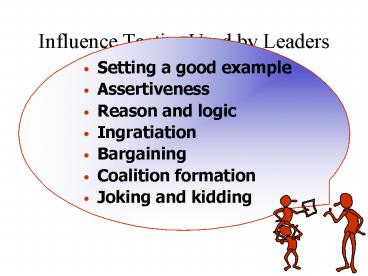Influence Tactics Used by Leaders - PowerPoint PPT Presentation
Title:
Influence Tactics Used by Leaders
Description:
SELECTED SLIDES Suggestions to Build Creativity Suggestions for Improving Group Problem-Solving Five Proven Stress Busters Four Managerial Functions & 17 Managerial ... – PowerPoint PPT presentation
Number of Views:27
Avg rating:3.0/5.0
Title: Influence Tactics Used by Leaders
1
Influence Tactics Used by Leaders
- Setting a good example
- Assertiveness
- Reason and logic
- Ingratiation
- Bargaining
- Coalition formation
- Joking and kidding
2
Characteristics of Effective Leaders
3
Behaviors of Effective Leaders
Adapt to the situation
Provide stable performance
Demand high standards of performance
Provide emotional support
Give frequent feedback
Have a strong customer orientation
Recover quickly from setbacks
Play the role of servant leader
4
Motivation and Ability as Factors in Performance
X
Adapted from Exhibit 12.2
5
The Basics of Goal Theory
Goals That Are Specific Difficult but
realistic Accepted by the person Used to evaluate
performance Linked to feedback and rewards Set by
individuals or groups
Improved Performance
Values
Adapted from Exhibit 12.5
6
The Communication Process
Feedback
Adapted from Exhibit 13.1
7
Types of Nonverbal Communication
Environment
Body placement
Facial expressions
Hand and body gestures
Voice quality
Posture
Dress and appearance
Mirroring
Use of time
8
Barriers to Communication
Input
Throughput (Noise)
Output
Communication Barriers Low Motivation and
Interest Inappropriate Language Defensive
Communication Filtering Insufficient Nonverbal
Communication Information Overload Poor
Communication Skills Electronic Communication
Problems
Message as Received
Message as Sent
Adapted from Exhibit 13.4
9
How to Conduct an Effective Meeting
10
The Links Between Controlling andthe Other
Management Functions
Control
Adapted from Exhibit 15.1
11
Steps in the Control Process
Adapted from Exhibit 15.3
12
Characteristics of Effective ControlsAn
effective control system is one that is
13
Factors Contributing to Ineffective Performance
- Related to Employee
- Insufficient mental ability, education, or job
knowledge - Job stress
- Low motivation
- Technological obsolescence
- Drug-related addiction
- Family or personal problems
- Related to Job
- Ergonomics problems
- Physically demanding, including heavy travel
- Built-in conflict
- Substandard industrial hygiene
- A sick building
- Related to Manager
- Inadequate communication about job
responsibilities - Inadequate feedback about job performance
- Inappropriate leadership style
- Intimidating manager
- Related to Organization
- Organizational culture that tolerates poor
performance - Counterproductive work environment
- Negative work group influences
- Sexual harassment
Adapted from Exhibit 16.1
14
The Control Model forManaging Ineffective
Performers
2. Detect deviation from acceptable performance
3. Define and assess the cause
1. Define performance standards
5. Set improvement goals
4. Communicate with substandard performer
6. Select and implement action plan
8. Continue or discontinue action plan
7. Re-evaluate performance after time interval
Adapted from Exhibit 16.3
15
Corrective Actions for Ineffective Performers
Organizational Programs
Managerial Actions and Techniques
- Coaching
- Closer supervision
- Reassignment or transfer
- Use of motivational techniques
- Corrective discipline
- Temporary leave
- Lower performance standards
- Job rotation
- Employee assistance programs (EAPS)
- Wellness programs
- Career counseling and outplacement
- Job redesign
- Training and development programs
Adapted from Exhibit 16.4
16
Suggestions to Improve a Managers Coaching Skills
17
Steps in Progressive Discipline
Adapted from Exhibit 16.5
18
How to Improve Work Habits and Manage Your Time































